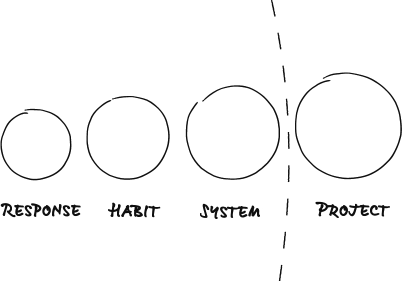Far better it is to dare mighty things, to win glorious triumphs, even though checkered by failure, than to take rank with those poor spirits who neither enjoy much nor suffer much, because they live in the gray twilight that knows not victory nor defeat.
Theodore Roosevelt, former US President
We saw in the discussion of the personal domain in part I that everything we do falls into one of five categories: instinct, response, habit, system or project. And we saw that projects are what rock, and that they are also the hardest to do.
When we look at the behaviour of teams, instincts disappear, and as we can see in the team projects model (figure 10.1), the line now passes between systems and projects. To the left of the line is business as usual. The area to the left is where the core business of a team or organisation happens, and the more efficient this is the better. To the right of the line is where new stuff is created, and where the biggest payoffs live. The projects that matter are what makes a team inspiring for its members. The elements to the left of the line pay the bills.
Figure 10.1: team projects model

Response
Within your team there are responses to stimuli that are either internal (from the team) or external (from customers, suppliers or other stakeholders). Let’s imagine that Jane is a surgeon, and she has a team that performs surgery with ...

